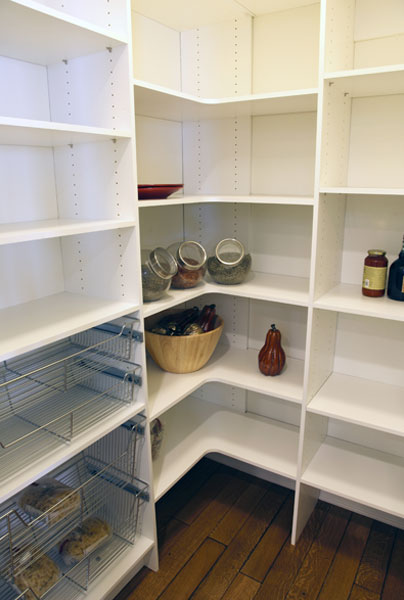There never seems to be enough storage space and the kitchen is no exception. One of the most popular features for kitchen remodels as well as new homes is a walk-in kitchen pantry.
A well-designed walk-in pantry provides a number of benefits. A walk-in pantry allows you to store more food, meaning fewer trips to the grocery store. It also affords you the space to buy in bulk, saving money. The additional space provided by a walk-in pantry also allows for better organization, making it easier to find what you need and less likely for food to get lost in the back of the pantry and exceed the expiration date. But a walk-in pantry can store more than just food. It can also be used to store dishes, pots and pans, small appliances, storage containers, and more.
Planning carefully is critical to ensuring you get the pantry you need without wasting valuable space. Think about how big your pantry needs to be. Start by making a list of everything that your pantry needs to be able store. At a minimum, it should be able to store at least a week’s worth of food for your family. This inventory will also help you determine the best shelving configuration. If you plan to store bulk items, you’ll want to make sure you have some tall, heavy duty shelves.
If you’re adding a walk-in pantry to an existing home, you’ll need to decide where it should be located. Ideally it should be close to the work space but in a place where it won’t interfere with other kitchen tasks. You’ll also want to opt for a cool, dry location away from appliances that produce heat and humidity, such as laundry appliances, the dishwasher, and the stove. This will help prevent spoilage and extend the shelf life of your food. If you don’t have adequate space to spare in the kitchen, consider an adjacent area, such as the hallway, under the stairs, or in a mudroom.
Proper shelving is a key component in a well-designed pantry. Shelves should be durable, able to support significant weight, and be easy to clean. Solid shelves prevent small items from falling through but can also trap crumbs and other debris. Wire shelves will allow food particles to fall through to the floor where they can be easily swept up, but small containers, like spice bottles, may fall through the wires as well. Whatever type of shelving you choose, make sure it can support the weight of heavy cans or bottles, large boxes or bags of food, pots and pans, and small appliances. Shelving that can be adjusted will allow you to change the configuration as needed. The depth of the shelves is also important. While you may be able to fit more on a deeper shelf, it also makes it much more likely that things will get lost in the back. The maximum recommended shelf width is 16 inches, but 12 to 14 inches is better. For smaller items or canned goods, 6 to 10-inch shelves work well. Putting shallower shelves at the top and deeper shelves at the bottom makes it easier to see what’s on the higher shelves.
Good lighting is another must-have for a walk-in pantry. While recessed overhead lighting will adequately light the top shelves and provide general illumination, it may leave the lower shelves in the dark. Adding LED strip lighting down the corners of the pantry will help illuminate each shelf.
There are a variety of features that can be incorporated into the design of your walk-in pantry to customize it to your specific needs. Wall racks, drawers, sliding shelves, movable bins, lazy susans, spice racks, bins, baskets, and slots for baking sheets and lids all help maximize the functionality of your pantry. Incorporating a counter or work surface will allow you to scoop or measure out food, eliminating the need to drag items into the kitchen. This is especially helpful with bulk items. Adding electrical outlets to your pantry will allow you to use small appliances inside the pantry. If you have the space, you can even include a small desk where you can pay bills or plan out menus for the week.

